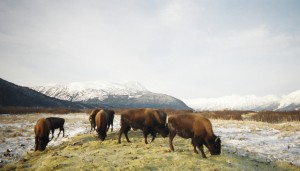Research finds wood and plains bison not subspecies
May 22, 2013

Nancy Tarnai
907-474-5042
5/20/13
DNA analysis does not support the designation of wood bison and plains bison as different subspecies, according to recently published research results from a University of Alaska Fairbanks scientist.
Wood bison from northwest Canada and plains bison from southern Canada and the Lower 48 have been designated as different subspecies, although scientists don't all agree that they should be. Wood bison are listed as an endangered subspecies, while plains bison are not.
‚ÄúThis is important because the Endangered Species Act allows subspecies to be listed as species," said Matthew Cronin, –‘”˚…Á professor of animal genetics. ‚ÄúThe ESA is mandated to use the best available science, so thorough assessment of the subspecies status is necessary.‚Äù
Cronin and his collaborators found that the animals in some plains bison herds are genetically more different from each other than some plains bison are from wood bison, yet those herds are not identifiable as two distinct groups. They also found that wood and plains bison are much more genetically similar than cattle subspecies and breeds, such as Angus and Texas Longhorn cattle.
The bison herds Cronin studied are located in Alaska, Montana, Utah, Wyoming, New York, Alberta and the Northwest Territories and include plains bison in Alaska at Delta Junction, Chitina, Copper River and Farewell, and wood bison at the Alaska Wildlife Conservation Center. Cronin’s findings are published in the online May 10 issue of the Journal of Heredity.
Cronin emphasized that the term “subspecies” denotes a formal taxonomic category and that evolutionary history is a primary criterion for subspecies designation. For example, European cattle and tropical cattle have separate origins, are genetically distinct and thus have a scientifically supported subspecies designation. Wood and plains bison originally had contiguous ranges, were mixed in the 1900s and are not genetically distinct groups. These factors do not support subspecies designation, he said.
“My work replicates previous work,” said Cronin. “I worked with different herds and got the same results, that they are not distinct subspecies.”
It’s common for wildlife to be named as subspecies without adequate evidence, Cronin said, often resulting in lack of consensus in the scientific community.
“This creates a paradox for biologists because subspecies can be designated by one author, rejected by another and still others reject the entire subspecies ranking,” he said. “These factors make formal designation of bison subspecies a seemingly intractable taxonomic exercise.”
Cronin said in his paper that plains bison and wood bison should be considered geographic populations and not subspecies.
“The bison subspecies are currently recognized by management agencies so their taxonomy needs to be assessed,” Cronin said. “I hope that bison management across North America can be done in a practical manner and not by preconceived notions about subspecies.”
Cronin is also doing genetic research studies on wolves and bears. The bison research was supported by the Alaska Department of Fish and Game. Cronin is a professor in the –‘”˚…Á School of Natural Resources and Agricultural Sciences and is based at the Matanuska Experiment Farm in Palmer.
CONTACT: Matthew Cronin, professor of animal genetics, 907-227-1753, macronin@alaska.edu.
Journal of Heredity article:


